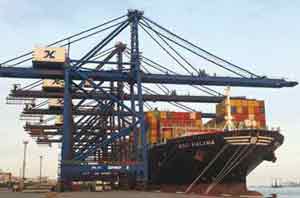A simple solution that is well worth its salt
Updated: 2011-10-28 09:29
By Hu Haiyan (China Daily)
|
|||||||||
|
A worker tests desalinated water that experts believe is an ideal alternative to scarce supplies of water. [Provided to China Daily] |
Desalination industry set for rapid growth
They are two of the most basic elements we consume, but when they are mixed few would choose to put them anywhere near their mouths. And therein may lie a path to riches.
We are talking about salt and water, and more precisely the process of removing salt from seawater, desalination.
That process is used, among other things, to deliver water to parched throats in areas where other sources of water are scarce or problematic.
A dozen or so countries have large desalination plants or are building them, among them China, where the industry driven by the prospect of huge profits, is taking off.
"The Chinese desalination market is of great potential and huge profits," says Yang Rong, sales department director with Hyflux China.
"We plan to accelerate expansion in China, setting up more plants involving desalination, water recycling and sewage water reclamation."
Hyflux, of Singapore, set up an office in Shanghai in 1993. Today its China business contributes 20 percent to its revenue and it has more than 40 projects throughout the country, including developing the largest seawater reverse osmosis desalination plant in Tianjin Dagang, about 150 kilometers southeast of Beijing.
Jorge Mora, Asia president of Veolia Environment of France, says the company, whose Asia-Pacific headquarters is in Beijing, is accelerating its pace in the Chinese desalination market.
"Currently, we have a lot of desalination projects under negotiation. China is the most important market for us in the world."
Over more than 10 years Veolia has invested nearly $2 billion in China, having 62 water disposal, water conservancy management and energy source projects in 41 cities on the mainland and in Hong Kong, Taiwan and Macao.
You Jinde, general secretary of the Membrane Industry Association of China, says that even if the desalination project market is still relatively small, the high returns, often 20 to 25 percent for desalination projects, mean it is likely to grow rapidly in the next few years.
Association research forecasts that China's desalination project market will have annual turnover of $860 million by 2015, he says.
"In some places the absence of conventional water solutions means desalination is not a choice but a necessity. And it is highly likely that soon the national government will deem seawater desalination to be another important water resource, which will boost the market," You says.
But some in the market are not so positive in their assessment.
"The Chinese desalination market is rather small," says Zhang Ruijin, vice-president of sales with Inge China, which specializes in innovative ultra-filtration technologies used in the treatment of drinking water, process water, seawater and waste water.
"Most aspects, including engineering research, project approval and advising the central government, are still monopolized by just a few big companies, which is unhealthy for the market's sound development."
Zhang says: "China still lacks supporting policies when it comes to safeguarding funds, allocating funds or subsidies, and mechanisms for developing desalination projects".
Low water tariffs is also another issue that affects the development of desalination in China.
"Desalination will only be a financially viable proposition to public utility supply when the water tariff reflects the investment and operation costs," says Wang Shichang, a professor at Tianjin University who specializes in desalination.
"At the moment desalination is not commercially attractive. On the average, desalinated water from a plant costs 8.15 yuan ($1.3, 0.9 euro) a ton in China, yet is sold at just 4 yuan a ton."












